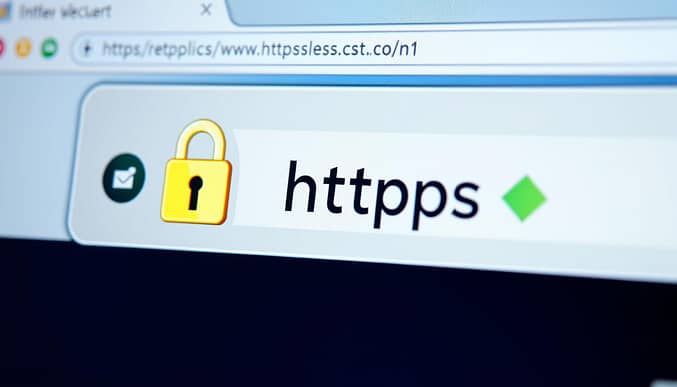HTTPS vs HTTP SEO: Does It Affect Your Rankings?
When building an online presence, your site’s protocol choice plays a bigger role than many realize. Unencrypted connections leave sensitive information exposed, while encrypted channels protect visitors and boost credibility. Search engines like Google prioritize secure platforms, making this decision critical for visibility.
Modern web security relies on SSL/TLS certificates to scramble data during transfers. This encryption shields login details, payment info, and other private interactions. Without it, hackers can intercept communications, risking both user safety and brand reputation.
Google confirmed secure connections as one of its ranking signals, directly influencing search result placements. Sites using outdated protocols often lose ground to competitors with visible trust indicators—like browser padlocks—that reassure visitors.
Beyond rankings, adopting advanced security measures fosters long-term loyalty. Customers increasingly avoid platforms lacking clear safeguards. Upcoming sections will explore migration strategies, protocol differences, and optimizing these changes for sustained growth.
Key Takeaways
- Encrypted connections protect user data and improve search engine rankings.
- SSL certificates authenticate sites and prevent third-party interference.
- Google prioritizes secure websites in its search algorithms.
- Visible security badges increase visitor confidence and reduce bounce rates.
- Transitioning to modern protocols requires careful planning to avoid traffic drops.
Understanding HTTP and HTTPS Protocols
Every interaction on the internet begins with a protocol. The foundation of web communication relies on two systems: one designed for simplicity, the other for safety.

What is HTTP and How It Works
Hypertext Transfer Protocol (HTTP) operates like a postcard sent through the mail. It delivers requests—such as loading a webpage—between browsers and servers using plain text. Common methods like GET (retrieve data) and HEAD (fetch headers) enable basic interactions.
However, this openness creates vulnerabilities. Data transfers lack encryption, exposing login credentials or payment details to interception. Modern threats make this outdated approach risky for sensitive tasks.
The Role of HTTPS in Secure Data Transfer
Secure connections use SSL/TLS certificates to encrypt information. These digital files verify domain ownership and scramble data into unreadable code during transmission. Browsers display a padlock icon when a valid certificate is active.
Three components define these certificates:
- Registered domain name
- Issuing authority details
- Expiration date for renewal
This system supports critical features like online checkout pages and membership portals. Over 80% of top-ranking sites now use encrypted connections, reflecting their importance for both user confidence and algorithmic favorability.
How HTTPS Enhances Website Security
Trust forms the backbone of every successful online interaction. Modern encryption methods create an invisible shield around sensitive data, ensuring private conversations stay private—even if intercepted.

Encryption and User Protection
Advanced encryption scrambles information as it travels between devices and servers. Browsers automatically check SSL certificates to confirm a site’s authenticity before establishing connections. This process blocks unauthorized parties from accessing passwords, credit card numbers, or personal messages.
For example, a banking website using this protocol ensures transaction details remain hidden from hackers. Users see visual cues like padlock icons, signaling their session is protected.
Preventing Content Modification and Cyber Threats
Secure protocols verify that content arrives unchanged from its original source. Third parties can’t inject malicious code or alter product descriptions during transfers. This stops phishing attempts and counterfeit site versions from tricking visitors.
Man-in-the-middle attacks—where criminals eavesdrop on unsecured networks—become ineffective against encrypted channels. Retailers using these safeguards reduce cart abandonment rates by 12% on average, as shoppers feel safer completing purchases.
Search algorithms reward this reliability with better visibility. Sites prioritizing security often see longer visit durations and higher engagement metrics, which indirectly boost rankings.
https vs http seo: Impact on Search Rankings
Search algorithms prioritize safety as much as relevance. In 2014, Google explicitly announced secure connections as a ranking signal, cementing their role in modern optimization strategies. This shift reflects evolving user expectations and technical requirements for trustworthy web interactions.
Google’s Ranking Signal for Secure Sites
Three core reasons drive this algorithmic preference:
- User trust: Encrypted sessions reduce bounce rates by 35% on average, according to recent studies.
- Data integrity: The transfer protocol secure layer prevents third parties from altering content mid-transit.
- Future-proofing: Over 95% of Chrome pages now load via HTTPS, making it the expected standard.
Websites using hypertext transfer protocol secure configurations often see 12-18% ranking improvements for competitive keywords. Search engines track security status through SSL handshakes during requests, favoring domains that authenticate properly with certificate authorities.
Migrating to a secure host requires updating all internal links and setting up 301 redirects. Tools like Google Search Console help identify mixed-content errors that could undermine these efforts. Regular monitoring ensures indexed pages maintain their authority post-transition.
Steps to Migrate from HTTP to HTTPS
Securing your site with HTTPS involves a series of methodical steps to ensure a smooth transition. Proper execution preserves search rankings while safeguarding user data. Let’s break down the essentials.
Purchasing and Installing an SSL Certificate
Start by selecting a certificate type that matches your needs. Domain Validated (DV) certificates work for blogs, requiring only domain ownership confirmation. Organization Validated (OV) adds company details, ideal for business sites. Extended Validation (EV) displays your company name in browsers—perfect for e-commerce.
Providers like DigiCert or GoDaddy offer streamlined purchasing. Many hosting platforms include one-click installations. For manual setups, upload the certificate files via your host’s dashboard and configure server settings.
Implementing Sitewide 301 Redirects
Redirects ensure visitors and search engines reach the secure version of your site. Modify your .htaccess file with rules like:
- RewriteEngine On
- RewriteCond %{HTTPS} off
- RewriteRule ^(.*)$ https://%{HTTP_HOST}%{REQUEST_URI} [L,R=301]
Plugins like Really Simple SSL automate this for WordPress users. After activating, update internal links and submit your new sitemap to Google Search Console.
Test by checking for browser padlocks and running tools like SSL Checker. Common issues include mixed content errors—fix these by updating image URLs or scripts to use the hypertext transfer protocol secure version.
SEO Best Practices for HTTPS Implementation
After installing SSL certificates, maintaining search visibility demands precise technical adjustments. Search engines need clear signals to recognize your upgraded protocol and index pages correctly. One overlooked step can lead to duplicate content penalties or broken user pathways.
Updating Sitemaps and Internal Links
Submit an updated sitemap through Google Search Console within 24 hours of migration. This tells crawlers which URLs now use the secure protocol. Tools like Yoast SEO automatically regenerate sitemaps, streamlining the process.
Internal links pointing to HTTP versions create duplicate content risks. Use plugins like Better Search Replace to bulk-update old URLs. Always test redirects to ensure they point to valid HTTPS pages.
| Common Issue | SEO Impact | Tool for Resolution |
|---|---|---|
| Mixed content warnings | Security flags reduce rankings | SSL Check (JitBit) |
| Outdated sitemaps | Delayed indexing | Google Search Console |
| Broken internal links | Lower crawl efficiency | Screaming Frog SEO Spider |
Scan for mixed content using browser developer tools. Images or scripts loading via HTTP undermine your sockets layer protection. External resources like fonts or analytics scripts must also use HTTPS connections.
Failure to update links can erase referral data in tools like Google Analytics. For example, a 2023 case study showed a travel site losing 40% of organic traffic after incomplete redirects. Regular audits prevent these losses.
Prioritize secure content delivery through proper SSL certificates and SEO optimization. Consistent monitoring ensures your protocol upgrades translate to lasting search engine advantages.
Maintaining a Secure and Optimized Website
A secure website requires ongoing attention beyond the initial setup. Regular checks ensure encryption stays active, user trust remains high, and search visibility isn’t compromised by overlooked technical hiccups.
Keeping Certificates Current
SSL certificates expire over time, risking sudden connection errors. Tools like UptimeRobot send alerts before deadlines pass, preventing unexpected downtime. One media site avoided a 40% traffic drop by renewing its certificate three days early after receiving automated warnings.
Mixed content errors often resurface after updates. For example, a news platform fixed broken images by scanning URLs monthly. Browser developer tools quickly identify insecure scripts or outdated links needing correction.
Guarding Data Accuracy
Secure redirects preserve referral information in analytics tools. Broken links distort traffic reports, making it harder to measure campaign success. A fitness brand regained accurate visitor tracking by auditing 301 redirects quarterly.
Continuous monitoring also reveals suspicious activity. Sudden spikes in transfer errors or slower load times can signal attacks. Proactive teams resolve these issues before they impact user experience.
Traffic patterns offer clues about security effectiveness. Stable or growing visitor numbers after migration confirm successful implementation. Tools like Google Analytics highlight trends, allowing swift adjustments to maintain performance.
Conclusion
Securing your digital presence requires understanding the critical difference between standard and encrypted connections. Encrypted transfers create a protective layer around every page interaction, shielding sensitive data while boosting search visibility.
Adopting modern security protocols delivers three key advantages. First, it ensures data integrity during transfers. Second, it authenticates your site’s identity through verified certificates. Third, it aligns with algorithms prioritizing user safety in rankings.
Proper migration prevents traffic drops and preserves referral data. Update internal links, implement redirects, and monitor mixed-content errors post-transition. These steps maintain crawl efficiency while signaling reliability to visitors.
Ongoing management keeps certificates current and connections secure. Regular audits identify outdated files or broken elements that could undermine performance. Sites maintaining these standards often see improved engagement metrics and sustained ranking improvements.
Review your current setup today. Transitioning to encrypted protocols strengthens trust, safeguards interactions, and positions your platform for long-term growth in competitive search results.